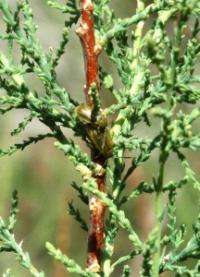Beetles chomping their way through salt cedar at Lake Meredith

Dr. Jerry Michels, a Texas AgriLife Research entomologist in Amarillo, is hopeful this will be the year major defoliation occurs on salt cedar that lines the banks of the waterways leading into Lake Meredith.
Plum Creek recreational area at Lake Meredith is the site of Michels’ biological control of salt cedar study. Lake Meredith is north of Amarillo and serves as a water source for 11 member cities of the Canadian River Municipal Water Authority.
Salt cedar is an invasive plant that uses a lot of water and degrades the environment that it is in, Michels said. It is usually found in riparian areas where there is a good source of water.
Kent Satterwhite, Canadian River Municipal Water Authority general manager at Fritch, said they have sprayed more than 20,000 acres of salt cedar along the waterways that lead into Lake Meredith, trying to control the invasive tree.
“We’re convinced that what we’ve sprayed so far has used more water than all of our member cities combined,” Satterwhite said. “So it is a huge water-hog, and the goal here is to try to help Lake Meredith and get some more water to the lake.”
The goal, with the water authority’s support of Michels’ salt cedar beetle study, is to maintain what has already been done, Satterwhite said. The beetles’ emergence and activity this year is encouraging.
Michels said without the support of the Canadian River Municipal Water Authority, he probably would not have gotten the project started. Not only was the funding important, but so was access to sites, protected sites where “we knew we could release these beetles and they wouldn’t be disturbed.”
The project began in 2004 when Michels first released some beetles that feed on salt cedar, but he says he’s had varying degrees of success over the years.
“Some of our earlier releases may have been with the wrong species of beetle or the wrong ecotype – came from the wrong area of the world,” he said. “For some reason, they just didn’t sit well with this situation.
“Over the years, we’ve made various releases of the beetle around Lake Meredith and we think we finally have a good establishment of a beetle that came from Crete, an island off of Greece,” Michels said. “The latitude is one of the most important considerations that we have, because the beetles’ reproductive system is based on photoperiod.”
He said they have found that if there aren’t enough hours of light during the summer, the beetles will think it is going into fall and they will start to hibernate early by burrowing into the ground. They starve to death during the winter.
“But we think we’ve got the right biotype now and it’s taken off here at Plum Creek and has done some extensive defoliation,” Michels said. “This is the second summer they have come out of hibernation; they spent the winter here.”
He said even in last year’s drought, the beetles seemed to flourish. And now, they have emerged early this spring and are showing signs of mating. If there are no hard freezes in the coming weeks, defoliation should begin in earnest.
The beetle can do a lot of damage to the salt cedar trees in just one season, he said. The adults and larvae girdle twigs, causing complete defoliation of even mature trees.
“Of course, if you have a big healthy tree, it’s going to take a couple years of defoliation to actually kill it,” Michels said. “But smaller trees and seedlings could be killed in the first season.”
Michels said while he is excited to see the beetles emerged for the second year in a row, he knows it is an ongoing process that will take time to see significant results.
Provided by Texas A&M University



















